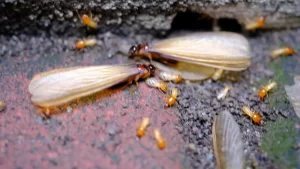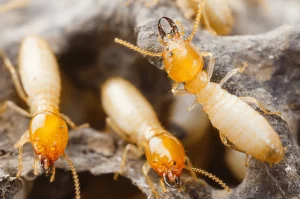Regardless of what type of termite has invaded your house or business its bad news for you. I know that you probably don’t care too much about the different kinds of termites right? You just want them gone. While it may seem trivial to find out which kind of termite you’re dealing with, the damage done to your house and the treatment will greatly depend upon which termite. In this article I will explain the differences between the two types of termites so that you can identify the different termites. Being able to identify the type of termite will allow you to take the appropriate action and exterminate the problem quicker.
When it comes to identifying termites, the devil is in the details. Winged termites are called alates and this is important because drywood alates have different wings than subterranean termites. Drywood alates wings’ have a complex system of veins running through them. While subterranean termites have a single, dark vein that runs parallel to the top of the wing, both alates shed their wings seconds after landing. So you’ll be able to tell if you have an infestation if you find wings and you’ll also be able to tell what kind of infestation you have.
The nesting habit of these two types of termites will also help you identify which termite is bothering you. This difference is actually fairly obvious because the answer is in the name. Drywood termites nest inside of the wood that they are infesting. This usually includes exposed wood inside the house like the attic, and furniture made of wood. You’ll be able to tell if there are drywood termites there by tapping on the wood and hearing a hollow sound. On the other hand, subterranean termites nest in the ground, hence subterranean. Subterranean termites travel underground and build mud tubes to reach their target. The mud tubes provide protection from dehydration and predators. These mud tubes can usually be found around and near the house making it relatively easy to identify an infestation.
This next difference will probably make you cringe in disgust, but you can tell the difference between the two by looking at their fecal excrement a.k.a. poop. As disgusting as it is, excrement is one of the most common secondary signs of an infestation. So when you find these little poops, it’s not just disgusting, but also the sign of a major problem. You probably don’t want to know the difference between the two termites’ excrements, but here you go. Subterranean termites excrement is non-ridged, cardboard like called carton. It’s harder to find cartons because subterranean termites incorporate their excrement into the mud tubes. Drywood termites’ excrement is dry and hard. These will be much easier to notice because drywood termites create “kick holes” which are holes in the wood that these termites push their fecal matter out. The fecal pellets then collect on the floor below the kick holes thus allowing you to spot the tiny piles forming.
As I mentioned before, the type of termite will decide what kind of treatment will be best to exterminate the problem from your house or business. Remedies for drywood termites include whole structure fumigation, spot treatment with insecticides, or spot heat, shock, microwave and liquid nitrogen treatment. These different termite removal services can all be effective ways of getting rid of drywood termites. Treating a subterranean infestation is slightly different than drywood termites. Treatments for a subterranean termite infestation include liquid termiticide, repellant termiticide, non-repellant termiticide, liquid termiticides, and subterranean termite baits.
Luckily for everybody, Nozzle Nolen offers a wide range of treatment options for both drywood and subterranean termite infestations. For drywood termites Nozzle Nolen offers tent fumigation, vault fumigation and tent-less treatment. Tent fumigation is used for larger infestations throughout entire houses or buildings. Vault fumigation is used to treat individual pieces of furniture. Tent-less treatment is used for those to treat localized infestations. Treatments for subterranean treatments include advance termite baiting system and termidor treatment. The baiting system uses bait that the termites will take back to the colony and kill the rest of the colony. The termidor treatment applies a pet friendly liquid around the yard and will kill the termites when they come in contact with it.
If you have any questions about termites or if you are interested in our pest control services, please contact us!
References
Harris, V. E. (n.d.). Comparison of Subterranean and Drywood Termites. Retrieved October 19, 2016, from IFAS Extension UF: http://pasco.ifas.ufl.edu/Termites_drywood-subterranean.shtml
Miller, D. M. (2010, March 5). Subterranean Termite Treatment Options. Retrieved 10 19, 2016, from Virginia Cooperative Extension: https://pubs.ext.vt.edu/444/444-500/444-500.html
State of Florida Department of Agriculture and Consumer Services. (n.d.). Consumer Information on Drywood Termites. Tallahassee, Florida, USA.

